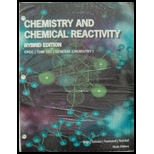
a)
Interpretation:
Consider the following half reactions.
The strongest and weakest oxidizing agent has to be determined.
Concept introduction:
Therese are chemical energy is converted into electrical energy.
In all electrochemical cells, oxidation occurs at anode and reduction occurs at cathode.
An anode is indicated by negative sign and cathode is indicated by the positive sign.
Electrons flow in the external circuit from the anode to the cathode.
In the electrochemical cells two half cells are connected with salt bridge. It allows the cations and anions to move between the two half cells.
Under certain conditions a cell potential is measured it is called as standard potential
Standard potential
The
The
Electrochemical series:
It is a decreasing order of the reduction potentials. The most positive
(b)
Interpretation:
Consider the following half reactions.
The oxidizing agents which are capable of oxidizing
Concept introduction:
Electrochemical cells:
Therese are chemical energy is converted into electrical energy.
In all electrochemical cells, oxidation occurs at anode and reduction occurs at cathode.
An anode is indicated by negative sign and cathode is indicated by the positive sign.
Electrons flow in the external circuit from the anode to the cathode.
In the electrochemical cells two half cells are connected with salt bridge. It allows the cations and anions to move between the two half cells.
Under certain conditions a cell potential is measured it is called as standard potential
Standard potential
The
The
Electrochemical series:
It is a decreasing order of the reduction potentials. The most positive
(c)
Interpretation:
Consider the following half reactions.
A balanced chemical equation for the reaction of
Concept introduction:
Electrochemical cells:
Therese are chemical energy is converted into electrical energy.
In all electrochemical cells, oxidation occurs at anode and reduction occurs at cathode.
An anode is indicated by negative sign and cathode is indicated by the positive sign.
Electrons flow in the external circuit from the anode to the cathode.
In the electrochemical cells two half cells are connected with salt bridge. It allows the cations and anions to move between the two half cells.
Under certain conditions a cell potential is measured it is called as standard potential
Standard potential
The
The
Electrochemical series:
It is a decreasing order of the reduction potentials. The most positive
(d)
Interpretation:
Consider the following half reactions.
A balanced chemical equation for the reaction of
Concept introduction:
Electrochemical cells:
Therese are chemical energy is converted into electrical energy.
In all electrochemical cells, oxidation occurs at anode and reduction occurs at cathode.
An anode is indicated by negative sign and cathode is indicated by the positive sign.
Electrons flow in the external circuit from the anode to the cathode.
In the electrochemical cells two half cells are connected with salt bridge. It allows the cations and anions to move between the two half cells.
Under certain conditions a cell potential is measured it is called as standard potential
Standard potential
The
The
Electrochemical series:
It is a decreasing order of the reduction potentials. The most positive
Trending nowThis is a popular solution!

Chapter 19 Solutions
CHEMISTRY+CHEM...HYBRID ED.(LL)>CUSTOM<
- 5. Write the formation reaction of the following complex compounds from the following reactants: 6. AgNO₃ + K₂CrO₂ + NH₄OH → 7. HgNO₃ + excess KI → 8. Al(NO₃)₃ + excess NaOH →arrow_forwardIndicate whether the product formed in the reaction exhibits tautomerism. If so, draw the structure of the tautomers. CO₂C2H5 + CH3-NH-NH,arrow_forwardDraw the major product of this reaction N-(cyclohex-1-en-1-yl)-1-(pyrrolidino) reacts with CH2=CHCHO, heat, H3O+arrow_forward
- Draw the starting material that would be needed to make this product through an intramolecular Dieckmann reactionarrow_forwardDraw the major product of this reaction. Nitropropane reacts + pent-3-en-2-one reacts with NaOCH2CH3, CH3CHOHarrow_forwardIndicate whether the product formed in the reaction exhibits tautomerism. If so, draw the structure of the tautomers. OC2H5 + CoHs-NH-NH,arrow_forward
- Explain how substitutions at the 5-position of barbituric acid increase the compound's lipophilicity.arrow_forwardExplain how substitutions at the 5-position of phenobarbital increase the compound's lipophilicity.arrow_forwardName an interesting derivative of barbituric acid, describing its structure.arrow_forward
- Briefly describe the synthesis mechanism of barbituric acid from the condensation of urea with a β-diketone.arrow_forwardGiven the hydrazones indicated, draw the structures of the enamines that can be formed. Indicate the most stable enamine (explain). C6H5 C6H5 H C6H5 Harrow_forward4. Propose a Synthesis for the molecule below. You may use any starting materials containing 6 carbons or less (reagents that aren't incorporated into the final molecule such as PhзP do not count towards this total, and the starting material can have whatever non-carbon functional groups you want), and any of the reactions you have learned so far in organic chemistry I, II, and III. Your final answer should show each step separately, with intermediates and conditions clearly drawn.arrow_forward
 Chemistry: The Molecular ScienceChemistryISBN:9781285199047Author:John W. Moore, Conrad L. StanitskiPublisher:Cengage Learning
Chemistry: The Molecular ScienceChemistryISBN:9781285199047Author:John W. Moore, Conrad L. StanitskiPublisher:Cengage Learning Chemistry: Principles and ReactionsChemistryISBN:9781305079373Author:William L. Masterton, Cecile N. HurleyPublisher:Cengage Learning
Chemistry: Principles and ReactionsChemistryISBN:9781305079373Author:William L. Masterton, Cecile N. HurleyPublisher:Cengage Learning Chemistry & Chemical ReactivityChemistryISBN:9781133949640Author:John C. Kotz, Paul M. Treichel, John Townsend, David TreichelPublisher:Cengage Learning
Chemistry & Chemical ReactivityChemistryISBN:9781133949640Author:John C. Kotz, Paul M. Treichel, John Townsend, David TreichelPublisher:Cengage Learning Chemistry for Engineering StudentsChemistryISBN:9781337398909Author:Lawrence S. Brown, Tom HolmePublisher:Cengage Learning
Chemistry for Engineering StudentsChemistryISBN:9781337398909Author:Lawrence S. Brown, Tom HolmePublisher:Cengage Learning Chemistry: Principles and PracticeChemistryISBN:9780534420123Author:Daniel L. Reger, Scott R. Goode, David W. Ball, Edward MercerPublisher:Cengage Learning
Chemistry: Principles and PracticeChemistryISBN:9780534420123Author:Daniel L. Reger, Scott R. Goode, David W. Ball, Edward MercerPublisher:Cengage Learning General Chemistry - Standalone book (MindTap Cour...ChemistryISBN:9781305580343Author:Steven D. Gammon, Ebbing, Darrell Ebbing, Steven D., Darrell; Gammon, Darrell Ebbing; Steven D. Gammon, Darrell D.; Gammon, Ebbing; Steven D. Gammon; DarrellPublisher:Cengage Learning
General Chemistry - Standalone book (MindTap Cour...ChemistryISBN:9781305580343Author:Steven D. Gammon, Ebbing, Darrell Ebbing, Steven D., Darrell; Gammon, Darrell Ebbing; Steven D. Gammon, Darrell D.; Gammon, Ebbing; Steven D. Gammon; DarrellPublisher:Cengage Learning





